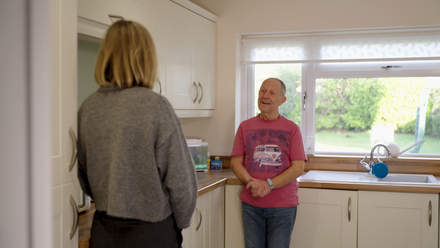Benedetta Andreotti presents a quality improvement initiative that transforms emergency care for older adults.
We all know that malnutrition is a global problem that, if not promptly diagnosed and treated, can lead to a variety of adverse consequences, including increased hospital admissions, delayed recovery from illness, increased risk of falls and increased mortality and morbidity. Malnutrition can be difficult to recognise, as it generally occurs gradually, making it difficult to detect in the early stages. As a result, it is often undiagnosed and untreated.
In view of the above, I wanted to propose a new model of care aimed at improving recognition of malnutrition, while optimising dietetic service efficiency. With support from my university supervisor, Kate Grimshaw, and the Dietetic Lead of Macclesfield Hospital, Holly Dempsey, I explored whether a dietetic assistant practitioner (DAP) working on A&E can improve patients’ care by providing a timely intervention to patients at risk of malnutrition, while reducing dietetic workload.
The hidden crisis of malnutrition
Malnutrition among older adults is a pressing issue in the UK, affecting approximately one in ten individuals over the age of 65, equating to over one million older adults nationwide.1 This statistic underscores the urgency of addressing this often-overlooked health concern. According to the National Institute for Health and Care Excellence (NICE), an individual is defined as malnourished if they present a body mass index (BMI) of <18.5kg/m2, or unintentional weight loss greater than 10% within the last three to six months, or a BMI of less than 20kg/m2 and unintentional weight loss greater than 5% within the past three to six months.2
Malnutrition is particularly prevalent among older adults due to various physiological changes associated with ageing. These include the development of medical conditions that cause difficulty breathing, changes in taste and smell, reduced ability to swallow, decreased appetite and increased nausea and vomiting.3
Additionally, older adults are more likely to experience functional disabilities such as difficulty shopping and cooking, increased frailty, and challenges in using cutlery due to tremors or poor muscle tone, all of which contribute to malnutrition.4 Furthermore, in the UK, 30% of the older population lives alone, a factor that increases social isolation, self-neglect, loneliness and ultimately malnutrition risk.1
The implications of malnutrition are far-reaching. These include delayed recovery from illness, increased hospital admissions, and higher mortality and morbidity rates. Economically, it places a significant burden on the healthcare system, with health and social care costs estimated to be around £23.5 billion per year in the UK.5 Therefore, early identification and intervention are crucial to improving patient care and reducing the economic strain on the NHS.
In the UK, the Malnutrition Universal Screening Tool (MUST) is used to identify adults who are malnourished or at risk of malnutrition.18 This validated tool should be applied to all patients within the first 24 hours of admission and weekly.9 It comprises five steps assessing BMI, unplanned weight loss in the past three to six months, and the acute disease effect (whether the patient is acutely ill and has, or is likely to have, no nutritional intake for more than five days). Each step is scored and the total score determines the level of malnutrition risk. However, despite the availability of this screening tool, malnutrition continues to be under-recognised in many hospitals due to suboptimal knowledge on its assessment, highlighting the need for improved training and awareness among healthcare professionals.19; 20
Dietitians play a central role in managing and treating malnutrition. They are the only healthcare professionals that assess, diagnose and treat dietary and nutritional problems. They provide recommendations, provision and monitoring of nutrition support, which can be via the oral, enteral or parenteral route.21 While dietitians are uniquely qualified to manage and treat malnutrition, they have one of the lowest workforce numbers in the NHS, making it difficult to tackle malnutrition alone.22
For this reason, non-dietetic healthcare professionals are also involved in the identification, assessment and management of malnutrition. In the UK, nurses are responsible for screening patients and referring them to dietitians for dietetic assessment and treatment. However, screening is not always practised correctly, resulting in undiagnosed or undocumented malnutrition.6 This dependence on other healthcare professionals for screening and referral can also result in long waiting times for patients and prolonged hospital stays. Unnecessary prolonged stays compromise patients’ safety, increase bed occupancy and cost, and impact the trust’s ability to provide a safe and timely intervention.7
In view of the above, our quality improvement project explored the effectiveness of implementing a model of care in which a DAP delivers early nutritional interventions in the A&E department at Macclesfield District General Hospital. The aim was to enhance patient care and safety for older adults at risk of malnutrition, while reducing pressures on the acute dietetic service and minimising breaches in referral response times. (According to the hospital policy, a breach occurs when oral nutrition support patients are not seen within five working days and tube patients are not seen within two working days.)
A new model of care
A DAP worked on A&E on eight consecutive Mondays. The DAP screened patients aged 65 and over by using the MUST. BMI, percentage of weight loss three to six months prior to patients’ admission, and the acute disease effect were taken into account. BMI was calculated from weight and height of the patients. Weight was taken with the hospital chair scale. If patients were bedbound, a mid-upper arm circumference (MUAC) was measured. Height was obtained from patients’ medical records and dietary intake was gathered through patient self-report or, when necessary, via medical records or the next of kin. By using the MUST, the DAP screened patients until five were found to be at risk of malnutrition (MUST ≥ 2) in a day. This resulted in a total of 40 patients recruited in the project.
In the first four weeks (control phase), patients received standard hospital care indicating that they had to wait for a formal referral to be sent to the dietetic team before receiving nutrition support. In the second four weeks (intervention phase), the DAP provided immediate nutritional support to at-risk patients without the need for a formal referral. In this phase, patients received an immediate action plan consisting of two daily bottles of Ensure Compact supplements (providing 600kcal and 25.6g of protein) along with additional snacks such as yoghurt, ice cream, custard, and cheese and crackers. Data was collected on time to referral, time to dietetic input, number of referrals and breaches, length of hospital stay, discharge destination and post-discharge dietetic support.
From delay to delivery: advancing dietetic access in emergency units
In the control group of our study, only 40% (n = 8) of the 20 patients were referred to the dietetic service, with an average delay of 11 days post-admission. This significant gap highlights a critical issue: malnutrition risk was not assessed within the recommended 24 hours, and the MUST was not being used effectively by nursing staff. This finding is consistent with previous research, which has demonstrated that malnutrition often goes undetected due to inconsistent or inadequate screening on admission.11, 12 In one study,13 only 15.2% of patients were identified as malnourished and referred to the dietetic team, when 56.7% of patients were actually malnourished. Common barriers to the accurate use of MUST include time pressures, lack of training or confidence in recognising malnutrition, and the perception that nutrition screening is not a priority – particularly in high-intensity environments like emergency departments.14 Although the emergency unit of the hospital is a fast-paced environment in which medical conditions are prioritised over nutritional needs, delayed or missed identification of malnutrition can lead to a cascade of adverse outcomes, including poorer clinical recovery, increased length of stay, higher readmission rates and even elevated mortality risk.6
Malnutrition also places a substantial financial burden on the healthcare system through prolonged hospital stays and increased care needs. The dietetic team took around five days to see the patients; hence patients were seen on time without breaches. However, due to the delay from the nursing team to send a formal referral, patients had to wait around 20 days before being seen by the dietetic service. This is a considerable and clinically significant delay, especially for patients who are acutely unwell and at high nutritional risk. Such delays not only compromise nutritional status but also increase the risk of clinical deterioration.17
On the other hand, the intervention phase introduced a DAP, stationed directly within the emergency unit. This proactive model removed the need for formal referrals, allowing patients to be assessed and treated at the frontline. The mean time to full dietetic assessment was significantly reduced by 20 days (p < 0.001). Notably, the introduction of the DAP also helped reduce the overall number of referrals and breaches, easing pressures on the wider dietetic service and enabling a more targeted, efficient approach to patient care.
The importance of timely dietetic input in emergency settings is also echoed in patient feedback. For instance, one study16 reported that wait times were a major source of dissatisfaction among patients, often contributing to feelings of anxiety, discomfort and confusion. Our findings support this, showing that early nutrition intervention is not only clinically beneficial but also valued by patients and their families.15
Furthermore, length of hospital stay was reduced in the intervention group, but results were not statistically significant. It is likely that multiple factors influenced length of stay, including patients’ medical complexity, palliative or end-of-life care status, or discharge delays due to the availability of appropriate post-acute placements. Previous research supports this view, with studies23 noting that, while nutrition interventions can support clinical recovery, they do not always lead to shorter hospitalisation periods due to these confounding factors.
The place of discharge and referral to community dietitians were also considered in our study. The majority of patients were discharged to their home, and only 32.5% of patients were referred to community dietitians. This means that two-thirds of patients received no ongoing nutritional support post-discharge – a troubling statistic that raises concerns about increased risks of malnutrition-related complications after hospitalisation.24
Challenges
There were a few challenges that we encountered. Firstly, it was noted that nurses did not screen any patients within 24 hours of their admission. Therefore, the DAP had to screen all patients on A&E, leading to time constraints. It was also challenging to communicate with a variety of patients. There were patients with dementia, patients who were confused, patients who were aggressive and patients who were non-verbal, as well as other hindering factors. The DAP had to use alternative methods of communication, including the use of gestures and writing on paper to ensure all the required information for the project was collected. Furthermore, some patients did not want to be weighed or could not be weighed with a chair scale as they were bedbound.
The DAP had to try alternative anthropometric measurements such as MUAC to obtain the BMI, and ulna length to obtain the height. However, this was also challenging, as some patients were moving during the assessment, resulting in possible inaccuracies. Another challenge was the fact that the DAP was not able to prescribe supplements, as they were not a qualified dietitian, so they had to ask the A&E doctors to prescribe them. Considering the fast-paced and dynamic nature of A&E, doctors were often very busy and were not able to prescribe immediately. As a result, some doctors could have forgotten to prescribe the supplements.
Areas for improvement
This project introduced a new model of care which allowed for the timely identification and treatment of patients who were at risk of malnutrition. It demonstrated that having a DAP ‘at the front door’ who worked collaboratively with the multidisciplinary team could significantly improve screening, reduce wait times to patients’ treatment and reduce workload for the dietetic team. However, some results were not statistically significant, such as the length of hospital stay. This is likely due to a variety of factors influencing patients’ hospitalisation, such as underlying medical complications, compliance to the nutritional intervention, patients being palliative/end of life and therefore not responding to treatment, or simply because patients were fit for discharge but were awaiting a place of discharge (e.g., nursing home or intermediate care), which prolonged their admission.
Another limitation is that our intervention was not tailored to the patients; it was a standard nutrition pathway consisting of two Ensure Compact supplement drinks a day and extra snacks. This could have also contributed to patients being non-compliant. We also didn’t provide any written information to patients, and most patients were not followed up upon discharge.
Providing patients with a diet sheet to minimise malnutrition could have been useful, so that patients could make more informed decisions on what to eat while in hospital and after discharge.
Finally, the DAP worked on A&E every Monday from 9am to 5pm and screened patients until five patients who were at risk of malnutrition were found in a day. This is a limitation, as there could have been more than five patients at risk of malnutrition within and outside working hours that were not recruited due to limited time and resources. This indicates that the percentage of malnutrition found in the study could have been biased.
Despite these limitations, this project was a real-world quality improvement study implemented in an integrated hospital system that used validated measures and involved the collaboration of the multidisciplinary team, resulting in improved nutrition screening practice. Furthermore, to our knowledge, it is the first study that explored how a timely intervention not only improves patient care but also alleviates dietetic workload.
Conclusion
In summary, we found that the introduction of a DAP on the emergency unit reduces time to provide a nutritional care plan to at-risk patients and improve patients’ care. Furthermore, the introduction of a DAP on the emergency unit can contribute to improved communication with nurses by raising awareness of malnutrition, which often goes under-recognised, while reducing the number of referrals and breaches for the dietetic department.
Moving forward
To ensure effective nutrition care in the future, we should consider investing money in training nurses to use MUST to improve the accuracy and consistency of malnutrition screening. We should also consider embedding a DAP to work on the emergency unit so that patients receive care in a timely manner. Dietetic interventions from the DAP should be tailored to the patients, as they are more likely to support patient engagement and long-term compliance.
Upon discharge, patients should be referred to community dietetics if they still present a MUST ≥ 2. Next steps include refining the nutrition pathway, assessing long-term feasibility and expanding the model to optimise acute dietetic services in emergency settings.
References
1 AGE UK. Malnutrition information and support [Internet]. Age UK. 2021. https://www.ageuk.org.uk/informationadvice/health-wellbeing/conditions-illnesses/malnutrition/
2 National Institute for Health and Care Excellence. Recommendations | Nutrition Support for adults: Oral Nutrition support, Enteral Tube Feeding and Parenteral Nutrition | Guidance | NICE [Internet]. www.nice.org.uk. 2017. https://www.nice.org.uk/guidance/cg32/chapter/Recommendations#screeningfor-malnutrition-and-the-risk-ofmalnutrition-in-hospital-and-thecommunity
3 Hickson M. “Malnutrition and ageing”. Postgraduate Medical Journal [Internet]. 2006 Jan 1;82(963):2–8. https://doi.org/10.1136/pgmj.2005.037564
4 Norman K, Hab U, Pirlich M. “Malnutrition in Older Adults—Recent Advances and Remaining Challenges”. Nutrients. 2021 Aug 12;13(8):2764. https://doi.org/10.3390/nu13082764
5 Brown F, Fry G, Cawood A, Stratton R. “Economic Impact of Implementing Malnutrition Screening and Nutritional Management in Older Adults in General Practice”. The journal of nutrition, health & aging. 2020 Feb 7;24(3):305–11. https://doi.org/10.1007/s12603-020-1331-6
6 Corriveau J, Alavifard D, Gillis C. “Demystifying Malnutrition to Improve Nutrition Screening and Assessment in Oncology”. Seminars in Oncology Nursing. 2022 Aug;38(5):151336. https://doi.org/10.1016/j.soncn.2022.151336
7 Silvester KM, Mohammed MA, Harriman P, Girolami A, Downes TW. “Timely care for frail older people referred to hospital improves efficiency and reduces mortality without the need for extra resources”. Age and Ageing. 2013 Nov 12;43(4):472–7. https://doi.org/10.1093/ageing/aft170
8 Kang MC, Kim JH, Ryu S-W, Moon JY, Park JH, Park JK, et al. “Prevalence of Malnutrition in Hospitalized Patients: a Multicenter Cross-sectional Study”. Journal of Korean Medical Science [Internet]. 2017 Nov 17;33(2). https://doi.org/10.3346/jkms.2018.33.e10
9 Van Vliet IMY, Gomes-Neto AW, de Jong MFC, Jager-Wittenaar H, Navis GJ. “High prevalence of malnutrition both on hospital admission and predischarge”. Nutrition. 2020 Sep; 77:110814. https://doi.org/10.1016/j.nut.2020.110814
10 Leandro-Merhi VA, dos Santos HAV, Almendra AAR, de Aquino JLB.” Nutritional indicators’ performance in malnutrition diagnosis of hospitalized elderly patients”. Experimental Gerontology [Internet]. 2023 Oct 1;181(1):112286. https://doi.org/10.1016/j.exger.2023.112286
11 Volkert D, Saeglitz C, Gueldenzoph H, Sieber CC, Stehle P. “Undiagnosed malnutrition and nutrition-related problems in geriatric patients”. The Journal of Nutrition, Health & Aging [Internet]. 2010 May 1 [cited 2021 Jan 4];14(5):387–92. https://doi.org/10.1007/s12603-010-0085-y
12 Bellanti F, lo Buglio A, Quiete S, Vendemiale G. “Malnutrition in Hospitalized Old Patients: Screening and Diagnosis, Clinical Outcomes, and Management”. Nutrients [Internet]. 2022 Jan 1;14(4):910. https://doi.org/10.3390/nu14040910
13 Suominen MH, Sandelin E, Soini H, Pitkala KH. “How well do nurses recognize malnutrition in elderly patients?” European Journal of Clinical Nutrition. 2007 Sep 19;63(2):292–6. https://doi.org/10.1038/sj.ejcn.1602916
14 O’Shea E, Trawley S, Manning E, Barrett A, Browne V, Timmons S. “Malnutrition in hospitalised older adults: A multicentre observational study of prevalence, associations and outcomes”. The journal of nutrition, health & aging [Internet]. 2017 Jul 1;21(7):830–6. https://doi.org/10.1007/s12603-016-0831-x
15 BDA. Dietetics in the hospital Emergency Unit [Internet]. www.bda.uk.com. 2019. https://www.bda.uk.com/resource/dietetics-inthe-hospital-emergency-unit.html
16 Shankar KN, Bhatia BK, Schuur JD. “Toward Patient- Centered Care: A Systematic Review of Older Adults’ Views of Quality Emergency Care”. Annals of Emergency Medicine. 2014 May;63(5):529-550. e1. https://doi.org/10.1016/j.annemergmed.2013.07.509
17 Sharma Y, Thompson CH, Kaambwa B, Shahi R, Hakendorf P, Miller M. “Investigation of the benefits of early malnutrition screening with telehealth follow up in elderly acute medical admissions”. QJM: An International Journal of Medicine. 2017 May 4;110(10):639–47. https://doi.org/10.1093/qjmed/hcx095
18 Cheah, K. and Illsley, A. (2020) ‘What you need to know about malnutrition in older adults.’ British Journal of Hospital Medicine, 2020 81(9) pp. 1–8. https://doi.org/10.12968/hmed.2020.0393
19 Tappenden, K. A., Quatrara, B., Parkhurst, M. L., Malone, A. M., Fanjiang, G. and Ziegler, T. R. (2013) ‘Critical Role of Nutrition in Improving Quality of Care: An Interdisciplinary Call to Action to Address Adult Hospital Malnutrition.’ Journal of the Academy of Nutrition and Dietetics, 2013 113(9) pp. 1219–1237. https://doi.org/10.1177/0148607113484066
20 Avelino-Silva, T.J. and Jaluul, O. ‘Malnutrition in Hospitalized Older Patients: Management Strategies to Improve Patient Care and Clinical Outcomes’, International Journal of Gerontology, 2017, 11(2), pp. 56–61. https://doi.org/10.1016/j.ijge.2016.11.002
21 Cook, F., Rodriguez, J. M. and McCaul, L. K. (2022) ‘Malnutrition, nutrition support and dietary intervention: the role of the dietitian supporting patients with head and neck cancer.’ British Dental Journal, 233(9) pp. 757–764. Available at: https://doi.org/10.1038/s41415-022-5107-8.
22 Dabbous, M., Hastings, R., Weekes, C. E. and Baldwin, C. ‘The role of non-dietetic healthcare professionals in managing interventions among adults at risk of malnutrition: A systematic review.’ Clinical Nutrition, 2021 40(7) pp. 4509–4525: https://doi.org/10.1016/j.clnu.2021.05.032.
23 Kruizenga, H. M., Van Tulder, M. W., Seidell, J. C., Thijs, A., Ader, H. J., & Van Bokhorst-de van der Schueren, M. A. Effectiveness and cost-effectiveness of early screening and treatment of malnourished patients. The American Journal of Clinical Nutrition, 2005, 82(5), 1082–1089. https://doi.org/10.1093/ajcn/82.5.1082.
24 Andersen, A.L., Nielsen, R.L., Houlind, M.B., Tavenier, J., Rasmussen, L.J.H., Jørgensen, L.M., Treldal, C., Beck, A.M., Pedersen, M.M., Andersen, O. and Petersen, J. ‘Risk of Malnutrition upon Admission and after Discharge in Acutely Admitted Older Medical Patients: A Prospective Observational Study’, Nutrients, 2021, 13(8), p. 2757: https://doi.org/10.3390/nu13082757







